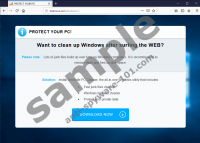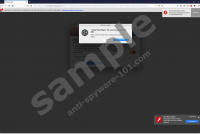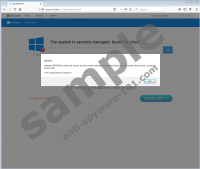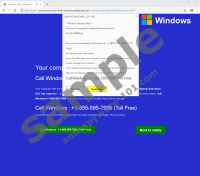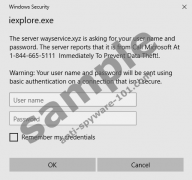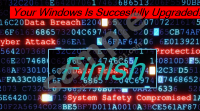If you access a website called professionalizing.space you might start seeing 'System Warning Alert' Pop-Ups that according to researchers are fake alerts. Meaning, they are not displayed by your operating system or your antimalware tool. If you want to know how you could end up on the mentioned website and what you should do if it happens, we encourage you to read our full article. A bit below the text you can find our deletion steps that show how to safely eliminate 'System Warning Alert' Pop-Ups by forcing your browser to close. If you need more help with the fake alerts removal or have any questions about them, do not hesitate to leave us a message in the comments area that is available at the end of this page. Read more »
category archyve:
Tidenous.com
Tidenous.com is an unreliable website that, according to our researchers, was built to promote suspicious applications. At the time of research, it was promoting a known PUP (potentially unwanted program) called “OneSafe PC Cleaner,” whose removal guide we created back in 2015. However, the download link that was placed on the website did not actually route to the installer of the PUP. It seems that the site is either broken or not yet fully built. Unfortunately, with slight modifications, the creator of this website could easily promote any PUP or malicious infection, and we certainly do not believe that OneSafe PC Cleaner is the only tool that it might push. Obviously, if you have been routed to this website and if you have downloaded anything promoted on it, we suggest scanning your system. Employ a trusted malware scanner, and it will help you figure out if you need to delete Tidenous.com-related threats. Once you scan the system, read this report in full to understand how this scam works. Read more »
Centerplaceofupgrade.pro
Do not trust messages introduced to you via https://soft4update.Centerplaceofupgrade.pro because they are misleading and fictitious. These messages might offer legitimate-looking installers – such as the Adobe Flash Player update – but, in reality, they hide the installers of various unreliable pieces of software. Hopefully, you have not been tricked by the scam yet, and you still have time to protect yourself. However, if you have downloaded software represented via it, you need to act quickly. According to our Anti-Spyware-101.com team, legitimate and desirable programs could be used to conceal adware, potentially unwanted programs (PUPs), and even malware. Therefore, before you even continue reading this report, we suggest examining your operating system. You can install a trustworthy free malware scanner for that purpose. Hopefully, no threats are found, and you can soon forget about the scam after adjusting your own behavior online. However, if you discover that you need to delete Centerplaceofupgrade.pro-related threats, get to it ASAP. Read more »
"ERROR # MS-SYSINFO32" Pop-Up
"ERROR # MS-SYSINFO32" Pop-Up is an old fake alert that has been designed to scare users into taking unnecessary action. The good news is that the original homepage for this fake alert is dead, and so the chances to encounter it in the vast spaces of the Internet. Nevertheless, there will probably be many other fake alerts out there that will try to push you into spending money. You need to be careful about the content you interact with because it can easily expose you to various security threats. There’s no way to remove "ERROR # MS-SYSINFO32" Pop-Up because it’s not on your computer in the first place, but there are methods to protect your system from harm. Read more »
Email Users Are Warned to Look out for the 'Jeanson J. Ancheta' Email Scam
Do you receive many emails every day? If you do, you might be quite careless when you open them. While opening emails will not get you into trouble, interacting with them by opening attached files, clicking links, or responding to strange messages could be very dangerous. The 'Jeanson J. Ancheta' Email Scam is the newest one that you need to look out for because the schemers behind it are trying to trick people into making unnecessary payments. Have you made a payment already? Hopefully, that is not the case because getting it back is not possible. Read more »
'The system is badly damaged, virus found (4)!' Pop-Ups
'The system is badly damaged, virus found (4)!' Pop-Ups are fake alerts that may show up if a user visits unreliable websites and interacts with questionable advertising content. These notifications might look legit due to Microsoft and Windows logos that might be displayed on them. It is essential to understand that Microsoft does not provide online virus scanners. Also, what should seem suspicious is that the scan is being performed without your permission. What we recommend for users who come across these fake alerts is to ignore what they say. Next, it is crucial to get rid of the 'The system is badly damaged, virus found (4)!' Pop-Ups and ensure that they do not come back. To do this, you could follow the instructions available below. For more information on these fake notifications, we invite you to read our full article. Read more »
Windows Warning Alert +1-855-595-7999
Windows Warning Alert +1-855-595-7999 may try to trick you into contacting a fake Windows Technical Support. According to our specialists, the false notification claims a computer is infected with a dangerous threat called Pornographic Spyware and that it is necessary to ask for assistance from the support center to get rid of it. Of course, in reality, the malicious application does not exist. If you want to know how the fake alert might appear on your browser or what could happen if you call the provided telephone number, you should read the rest of this report. A bit below it you can find instructions explaining how to eliminate Windows Warning Alert +1-855-595-7999 if you cannot close it. To make sure it will not come back, our researchers advise scanning the computer with a legitimate antimalware tool that could remove threats that might be related to the notification. For users who have more questions about the pop-up, we wish to remind that there is a comments space below where messages can be left. Read more »
1-844-665-5111 Pop-Ups
1-844-665-5111 Pop-Ups come from a scammers website known as wayservice.xyz. Meaning, the pop-ups do not come from Microsoft and they are not shown by your operating system. Consequently, not doing what they tell you is not only a good idea, but also highly advisable. Of course, the smartest thing to do after encountering these fictitious alerts would be to get rid of them, which is why we provide instructions showing how to do so just a bit below this article. Also, our researchers advise checking your system with a legitimate antimalware tool since there is a possibility 1-844-665-5111 Pop-Ups could be loaded by some threat on the computer. Plus, it would help to make sure, nothing potentially dangerous got in after interacting with the notifications. To learn more about them, we invite you to read our full report. Read more »
Critical Warning 888-412-7389
The devious Critical Warning 888-412-7389 scam is targeted at Windows users with vulnerable operating systems. The warning does not show up out of nowhere, and it is fully dependent on a malicious .exe file that is dropped onto the computer silently. Needless to say, if the operating system is protected and guarded, this malicious file could not be executed. Therefore, besides thinking about the malicious threat, you also should think about your virtual security. If you do not take appropriate steps to secure your operating system, other kinds of malicious threats could try to invade! In this report, we focus on helping you delete Critical Warning 888-412-7389 file, but do not forget that you need to think about security overall as well. Anti-Spyware-101.com research team is ready to answer your questions, and the comments section is open to anyone and everyone. Read more »
"Microsoft detected an unsolveable Therat" Locker
"Microsoft detected an unsolveable Therat" Locker appears to be a fake alert. Even though the notification’s developers tried their best to make it look like the message was displayed by the device’s operating system, its tone and grammatical mistakes raise suspicion. If you have encountered this questionable warning too, we encourage you to read our report carefully so you would not fall for the scam. Further, in the article, we will tell more details about this fake alert, for example, where it might come from and what to do if you encounter it. Also, at the end of the article, we will place instructions explaining how to remove "Microsoft detected an unsolveable Therat" Locker from the system. Thus, if you are here to learn how to delete the threat, you may want to have a look at the provided steps. Read more »
